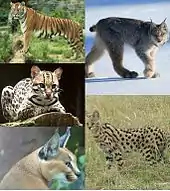Felinin
Felinin ist eine nichtproteinogene Aminosäure, die im Urin von verschiedenen Katzen vorkommt. Felinin ist die Vorläufersubstanz für den bakteriellen Abbau durch eine bakterielle Lyase, wodurch das vermutete Katzen-Pheromon 3-Mercapto-3-methylbutan-1-ol (MMB) entsteht.[2][3][4]
| Strukturformel | |||||||||||||
|---|---|---|---|---|---|---|---|---|---|---|---|---|---|
 | |||||||||||||
| Allgemeines | |||||||||||||
| Name | Felinin | ||||||||||||
| Andere Namen |
| ||||||||||||
| Summenformel | C8H17NO3S | ||||||||||||
| Externe Identifikatoren/Datenbanken | |||||||||||||
| |||||||||||||
| Eigenschaften | |||||||||||||
| Molare Masse | 207,29 g·mol−1 | ||||||||||||
| Sicherheitshinweise | |||||||||||||
| |||||||||||||
| Soweit möglich und gebräuchlich, werden SI-Einheiten verwendet. Wenn nicht anders vermerkt, gelten die angegebenen Daten bei Standardbedingungen. | |||||||||||||
Vorkommen

Felinin wird unter anderem von Rotluchsen, Graukatzen, chilenischen Waldkatzen und Hauskatzen ausgeschieden.
Biosynthese
Durch eine Kondensationsreaktion von Glutathion und Isopentenylpyrophosphat wird in der Leber 3-Mercaptobutanolglutathionin (3-MBG) gebildet.[5] Im Blut kommt zudem das Tripeptid γ-Glutamylfelinylglycin (GFG) vor.[6] In der Niere wird 3-MBG hydrolysiert zu Felinin und teilweise acetyliert. Daneben hydrolysiert die Protease Cauxin im Urin vorkommendes Felinylglycin zu Felinin.[7] Daher sind Felinin, Acetylfelinin, Felinylglycin und 3-MBG im Urin vorhanden.[8] Die Katzenpheromone 3-Mercapto-3-methyl-1-butanol, 3-Mercapto-3-methylbutylameisensäure, 3-Methyl-3-methylthio-1-butanol und 3-Methyl-3-(2-methyl-disulfanyl)-1-butanol sind vermutlich Abbauprodukte von Felinin.[9]
Die Biosynthese von Felinin ist Testosteron-gesteuert.[10] Die Konzentration von Felinin im Urin fällt nach der Kastration männlicher Katzen auf etwa ein Drittel und ist dann geringfügig höher als bei weiblichen Katzen oder kastrierten weiblichen Katzen.
Einzelnachweise
- Dieser Stoff wurde in Bezug auf seine Gefährlichkeit entweder noch nicht eingestuft oder eine verlässliche und zitierfähige Quelle hierzu wurde noch nicht gefunden.
- Discovery of felinine: Westall, R. G. "Amino acids and other ampholytes of urine. II. Isolation of a new sulfur-containing amino acid from cat urine" Biochemical Journal (1953), 55, 244-8.
- W.H. Hendriks, P.J. Moughan, M.F. Tarttelin, A.D. Woolhouse: Felinine: a urinary amino acid of Felidae. In: Comp. Biochem. Physiol. 112B. Jahrgang, Nr. 4, 1995, S. 581–588.
- P. David Josephy: Molecular Toxicology. Oxford University, 2006, ISBN 978-0-19-977145-5, S. 376 (google.com [abgerufen am 29. Juli 2013]).
- K.J. Rutherfurd, S.M. Rutherfurd, P.J. Moughan, W.H. Hendriks: Isolation and Characterization of a Felinine-containing Peptide from the Blood of the Domestic Cat (Felis catus). In: J. Biol. Chem. 277. Jahrgang, Nr. 1, Januar 2002, S. 114–119, doi:10.1074/jbc.M107728200, PMID 11698402 (englisch).
- K. J. Rutherfurd, S. M. Rutherfurd, P. J. Moughan, W. H. Hendriks: Isolation and characterization of a felinine-containing peptide from the blood of the domestic cat (Felis catus). In: The Journal of biological chemistry. Band 277, Nummer 1, Januar 2002, S. 114–119, doi:10.1074/jbc.M107728200, PMID 11698402.
- M. Miyazaki, T. Yamashita, Y. Suzuki, Y. Saito, S. Soeta, H. Taira, A. Suzuki: A major urinary protein of the domestic cat regulates the production of felinine, a putative pheromone precursor. In: Chem. Biol. 13. Jahrgang, Nr. 10, Oktober 2006, S. 1071–1079, doi:10.1016/j.chembiol.2006.08.013, PMID 17052611 (englisch).
- W.H. Hendriks, D.R.K. Harding, K.J. Rutherfurd-Markwick: Isolation and characterisation of renal metabolites of g-glutamylfelinylglycine in the urine of the domestic cat (Felis catus). In: Comp. Biochem. Phys. 139. Jahrgang, Nr. 2, 2004, S. 245–251, doi:10.1016/j.cbpc.2004.07.007, PMID 15465671 (englisch).
- V. V. Voznessenskaya: Influence of Cat Odor on Reproductive Behavior and Physiology in the House Mouse: (Mus Musculus). In: C. Mucignat-Caretta (Herausgeber): Neurobiology of Chemical Communication. CRC Press/Taylor & Francis, Boca Raton, 2014. PMID 24830030, Kapitel 14.
- D. Allaway, M. S. Gilham, A. Colyer, T. J. Jönsson, K. S. Swanson, P. J. Morris: Metabolic Profiling Reveals Effects of Age, Sexual Development and Neutering in Plasma of Young Male Cats. In: PloS one. Band 11, Nummer 12, 2016, S. e0168144, doi:10.1371/journal.pone.0168144, PMID 27942045, PMC 5152928 (freier Volltext).